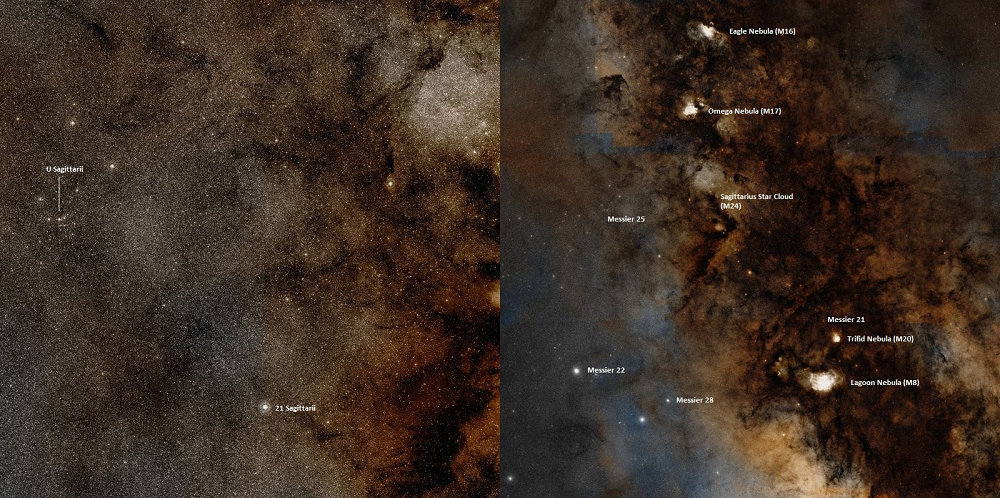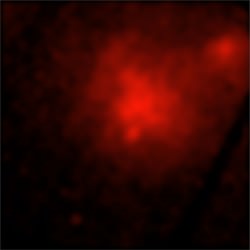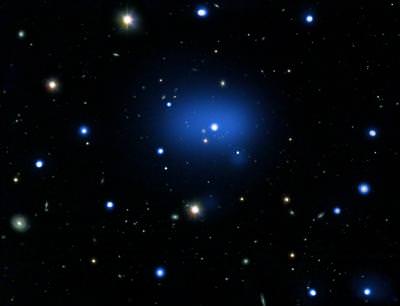Welcome back to Messier Monday! In our ongoing tribute to the great Tammy Plotner, we take a look at the Messier 25 open star cluster. Enjoy!
Back in the 18th century, famed French astronomer Charles Messier noted the presence of several “nebulous objects” in the night sky. Having originally mistaken them for comets, he began compiling a list of these objects so that other astronomers wouldn’t make the same mistake. Consisting of 100 objects, the Messier Catalog has come to be viewed as a major milestone in the study of Deep Space Objects.
One of these objects is Messier 25, an open star cluster located in the direction of the Sagittarius Constellation. At a distance of about 2000 light years from Earth, it is one of the few Messier Objects that is visible to the naked eye (on a clear night when light conditions are favorable).
Description:
This galactic star cluster was originally discovered by Philippe Loys de Cheseaux in 1745 and included in Charles Messier’s catalog in 1764. Oddly enough, it was one of those curious objects that didn’t get cataloged by Sir John Herschel – therefore it never received a New General Catalog (NGC) number.
This is odd, considering that it was part of the 1777 catalog of Johann Elert Bode, observed by William Herschel in 1783, written about by Admiral Smyth in 1836 and even commented on by the Reverend Thomas William Webb in 1859! It was until J.L.E. Dreyer in 1908 that poor little M25 ended up getting added to the second Index Catalog.
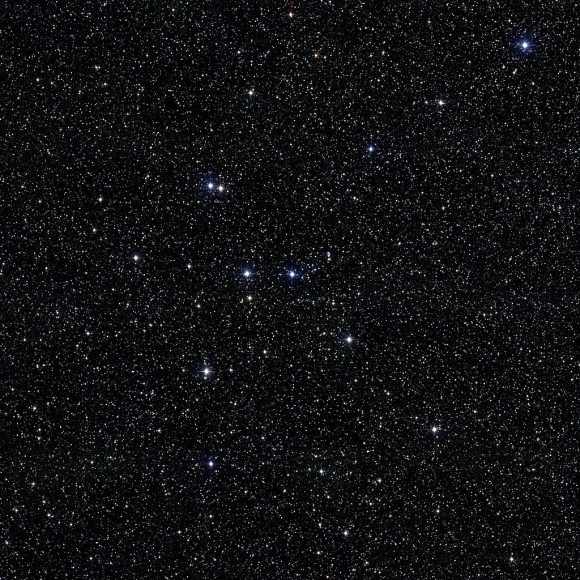
Cruising along peacefully about 2,000 light-years away from Earth, this little group of stars spans across about 19 light years of space. Caught inside of its influence are four giant stars – two of spectral type M and two of type G. As we know, it contains the variable star U Sagittarii, a Delta Cephei-type, which lets us know this group of 86 or so stars may have began life together as long ago as 90 million years.
But how many stars are really in there? If you’re using a large aperture telescope, you’re probably detecting the signature of several just beyond the threshold limits. And so has more recent scientific studies. According to a study by A.L. Tadross (et al.) of the National Research Institute of Astronomy and Geophysics:
“The young open star cluster M25 (IC 4725) is located in the direction of the galactic center in a crowded region, near much irregular absorption features on Sagittarius arm. This cluster has some difficult observing problems due to its southern location. The mass data available in the literature have been gathered to re investigate this cluster using most photometric tools to determine its main photometric parameters. More than 220 stars with mean reddening of 0.50 mag and absorption of 1.62 mag are found within the cluster.”
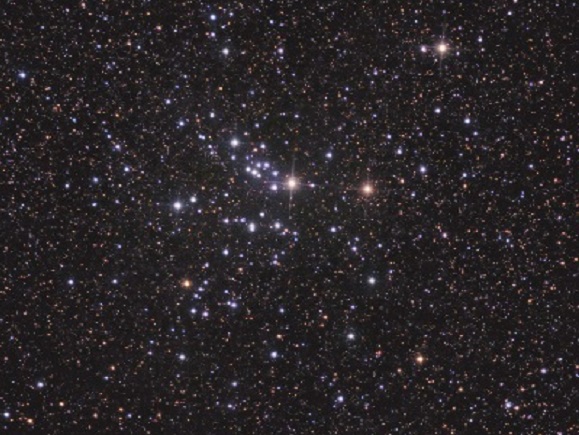
And how many of those stars are surprises? Let’s try a few blue straggler stars. According to a study titled “Blue Stragglers, Be stars and X-ray binaries in open clusters“, by A. Marco (et al):
“Combination of high-precision photometry and spectroscopy allows the detailed study of the upper main sequence in open clusters. We are carrying out a comprehensive study of a number of clusters containing Be stars in order to evaluate the likelihood that a significant number of Be stars form through mass exchange in a binary. Our first results show that most young open clusters contain blue stragglers. In spite of the small number of clusters so far analyzed, some trends are beginning to emerge.In younger open clusters, such as NGC 869 and NGC 663, there are many blue stragglers, most of which are not Be stars. In older clusters, such as IC 4725, the fraction of Be stars among blue stragglers is very high. Two Be blue stragglers are moderately strong X-ray sources, one of them being a confirmed X-ray binaries. Such objects must have formed through binary evolution. We discuss the contribution of mass transfer in a close binary to the formation of both blue stragglers and Be stars.”
History of Observation:
Perhaps we know more about it today than our historic antecedents, but our knowledge of its existence is owed to astronomers like Charles Messier, who took the time to catalog it. As he wrote in his notes:
“In the same night, June 20 to 21, 1764, I have determined the position of another star cluster in the vicinity of the two preceding, between the head and the extremity of the bow of Sagittarius, and almost on the same parallel as the two others: the closest known star is that of the sixth magnitude, the twenty-first of Sagittarius, in the catalog of Flamsteed: this cluster is composed of small stars which one sees with difficulty with an ordinary refractor of 3 feet: it doesn’t contain any nebulosity, and its extension may be 10 minutes of arc. I have determined its position by comparing with the star Mu Sagittarii; its right ascension has been found at 274d 25′, and its declination at 19d 5′ south.”
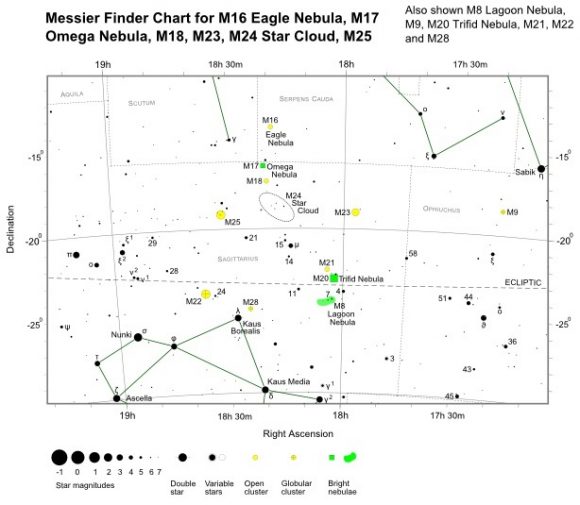
Perhaps William Herschel understood there was more there to be seen, for he commented in his unpublished notes; “Very large, bright, stars and some small, faint ones; I counted 70, and there are many more within no considerable extent.”
Yet, it was Admiral Smyth who really understood what lay beyond. From his observations, he wrote:
“A loose cluster of large and small stars in the Galaxy, between the Archer’s head and Sobieski’s shield; of which a pair og 8th magnitudes, the principle of a set something in the form of a jew’s harp, are above registered. The gathering portion of the group assumes an arched form, and is thickly strewn in the south, on the upper part, where a pretty knot of minute glimmers occupies the center, with much star-dust around. It was discovered in 1764 by Messier, and estimated by him at 10′ in extent: it is 5 deg to the north-east of Mu Sagittarii, and nearly on the parallel of Beta Scorpii, which glimmers far away in the west.”
Locating Messier 25:
Finding Messier 25 with binoculars is quite easy. Simply start at the teapot “lid” star, Lambda, and aim about a fist width almost due north. Here you will encounter a a Cepheid variable – U Sagittarii. This one is a quick change artist, going from magnitude 6.3 to 7.1 in less than seven days, so although it is a cluster member, it may fade on you from time to time as a marker star!
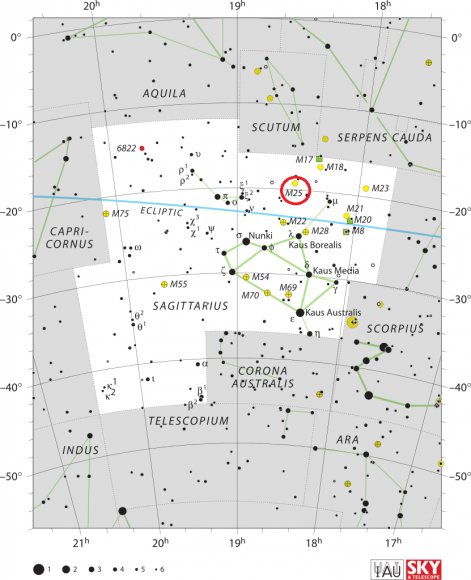
M25 will appear a a loose, but bright association of stars in binoculars and as a faint hazy spot in binoculars – but behold incredible resolution in a telescope. You’ll love the different magnitudes, so stick to around low to medium magnifications to enjoy it most.
As always, here are the quick facts. Enjoy!
Object Name: Messier 25
Alternative Designations: M25, IC 4725
Object Type: Open Galactic Star Cluster
Constellation: Sagittarius
Right Ascension: 18 : 31.6 (h:m)
Declination: -19 : 15 (deg:m)
Distance: 2.0 (kly)
Visual Brightness: 4.6 (mag)
Apparent Dimension: 32.0 (arc min)
We have written many interesting articles about Messier Objects here at Universe Today. Here’s Tammy Plotner’s Introduction to the Messier Objects, , M1 – The Crab Nebula, M8 – The Lagoon Nebula, and David Dickison’s articles on the 2013 and 2014 Messier Marathons.
Be to sure to check out our complete Messier Catalog. And for more information, check out the SEDS Messier Database.
Sources:

